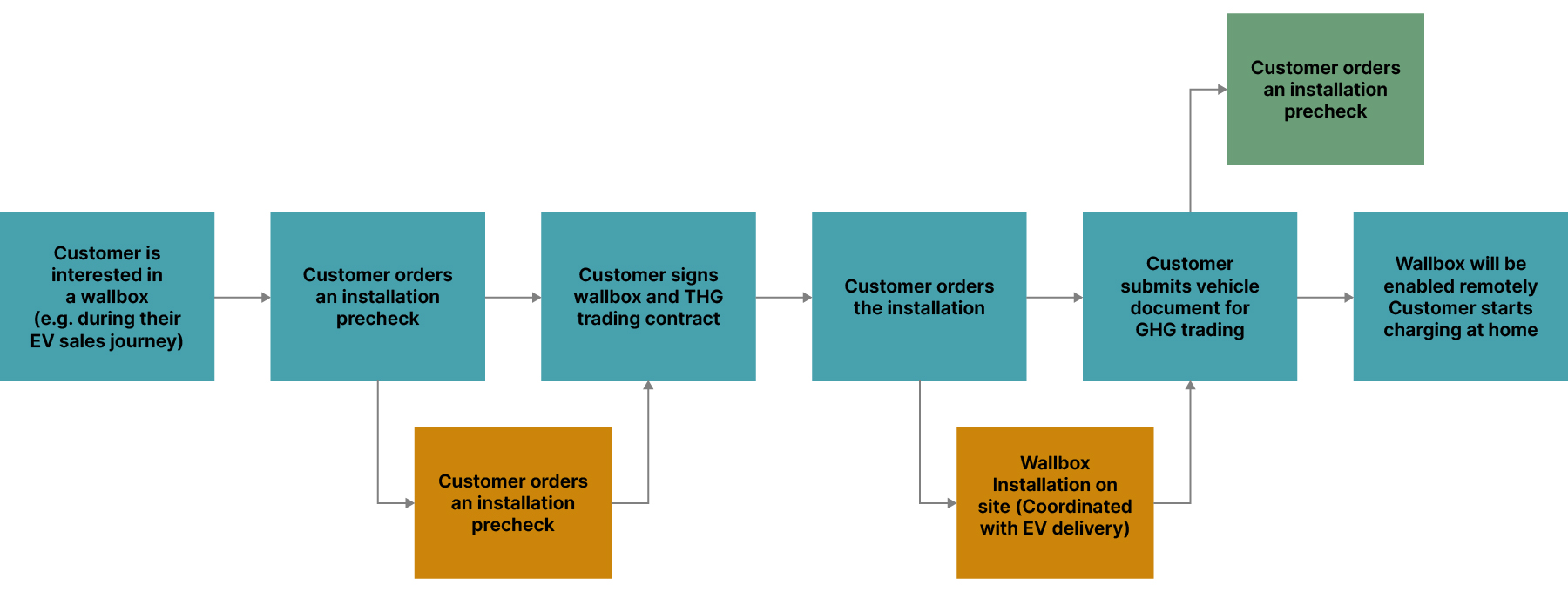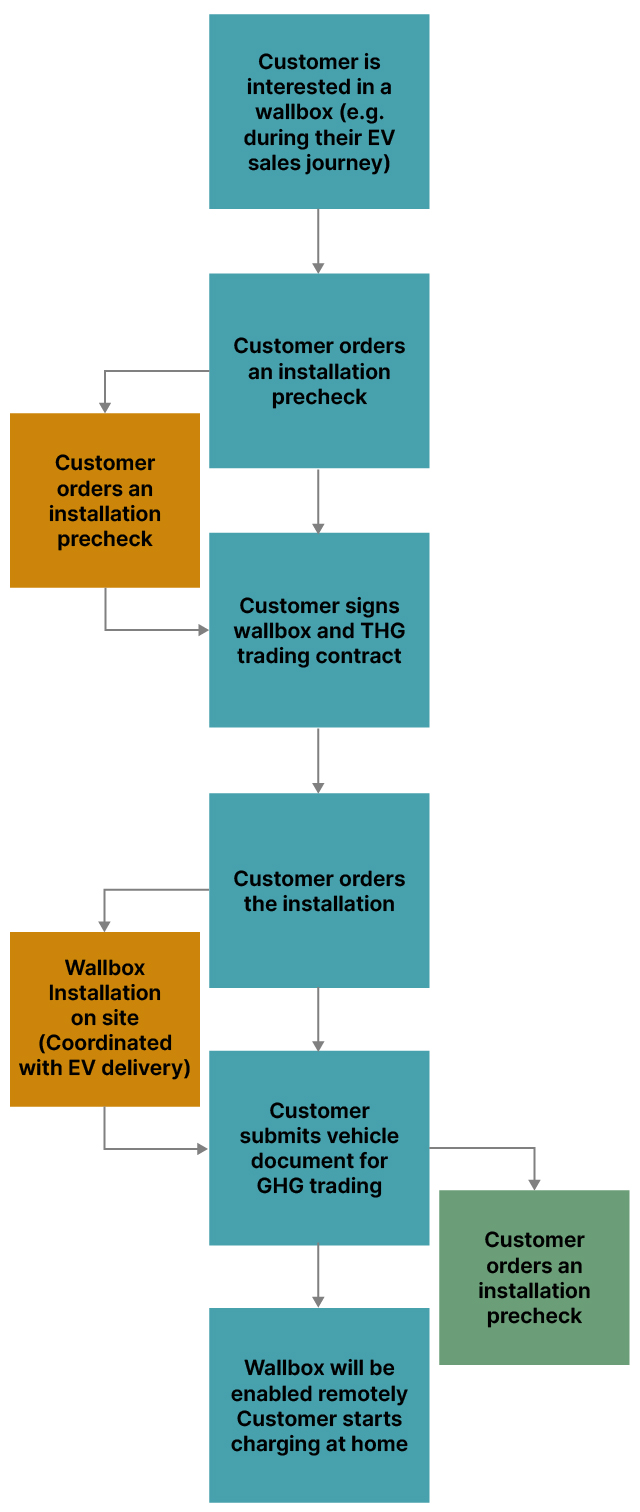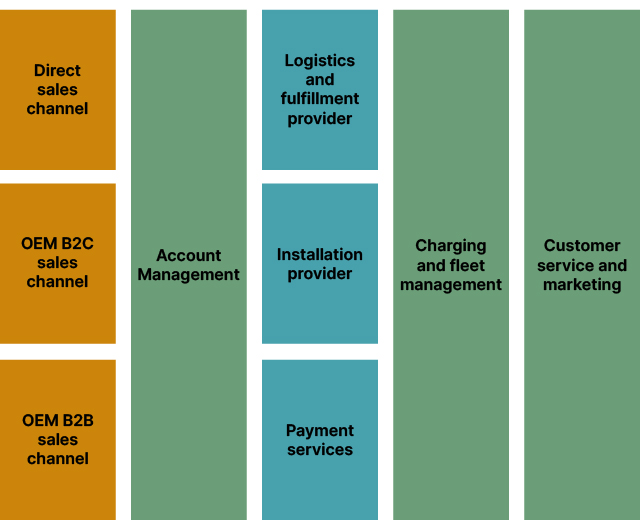Over the last years, uptake of Electric Vehicles (EV) has surged, with 10.2 million new battery-powered vehicles sold in 2022 alone. But for many consumers, one major barrier is still preventing them from buying their first EV — the accessibility of convenient charging infrastructure.
That’s a challenge that our client, a leading automotive investor, is helping to solve, through the creation of an EV charging venture startup. The go-to-market vision is to offer an EV charging experience based on a new Wallbox-as-a-Service offering. At the core of this, is a premium customer experience with remote pre-checks, convenient installation and user-friendly payment options, as well as a greenhouse gas quota trading service.
Customer journey overview


Designing the platforms and services to support this vision is a complex undertaking, and demands the right combination of customer, domain, technology, and experience design expertise. To investigate product-market-fit, design the overall service and bring the platform to life, we’ve set up a cross-functional team, collaborating closely with the client.
From application building to service and platform design
As a vision, the project was scoped as a straightforward application design. But through a series of design thinking workshops, we quickly uncovered that the service had to integrate with several service providers and platforms for installation, payment, and fulfillment, so what we were really dealing with was a platform design project.
This expansion in scope created both valuable opportunities and challenges. It gave us the opportunity to introduce product and platform thinking to the project and ensure a good product-market fit for the platform.
The team embarked on a multi-phase process that started with designing the right business model. Once the latter was understood and mapped out, we were able to move onto service design, ensuring that the startup’s service would support the business model, and deliver exactly what its prospective customers want from a charging platform-as-a-service.
After extensive testing and market validation, we settled on a final design, which helped visualize and plan the next vital stage of the project — designing a customer-friendly platform to bring the offerings to life.
Building a lean EV MVP in 90 days
To deliver value quickly, the team began work on an MVP, focused on the B2C sales journey through car dealerships. Through a series of discovery sessions with car dealers and additional customer and market research, we quickly discovered that very few organizations supported the entire customer EV charging journey, from installation to payment.
By building an MVP version of the platform, we were able to quickly introduce the service to the B2B market and build excitement and interest. It also gave the chance to start learning how customers, dealers, and manufacturers might engage with it once it’s complete — enabling to design new features around them.
Keeping everything aligned to customer value
Soon after, the team began extending and expanding the platform with features and capabilities based on market and user feedback. With a wide range of end-users and customers to consider, a lot of features were proposed, but to keep the project on track, the team ensured that every new capability developed was tightly aligned with customer value and platform capabilities.
Bringing a transformational platform-based service to market at speed
Only a few weeks after Golive of the platform, the service is being bought continuously to customers and is actively used by more than 250 vehicle dealerships.
After the successful launch phase, the platform has been expanded to whitelabel channels and business models, offering exclusive wallbox-as-a-service packages to OEM partners, who expect tailored services for their customers and dealership partners.
Product & service domain overview


The initial version of the platform acts as a foundation for its growth and expansion. Numerous market-validated features and capabilities are planned, and the team has a clear roadmap to help bring all of their ambitions for the platform to life.
While at the beginning, scope and ambition of the service were yet to be validated in the market, after being able to get a version up and running quickly, the startup could step into a product-led phase - letting customers and partners guide how the platform evolves, and deliver a customer-centric end-to-end EV charging solution.
To learn more about how Thoughtworks could help you build your own platform-based services, visit our service offerings.
What is GHG?
In Germany, owners of a BEV (Battery Electric Vehicle) can request one GHG certificate per year as a reward for their contribution to the emission reduction efforts. The entitlements of these certificates can be bundled and traded with on a public trade market with rock solid revenues for bundles. This market usually is not accessible for private or low volume customers but there are multiple platforms and services that offer to buy the certificates for a fixed amount.


















